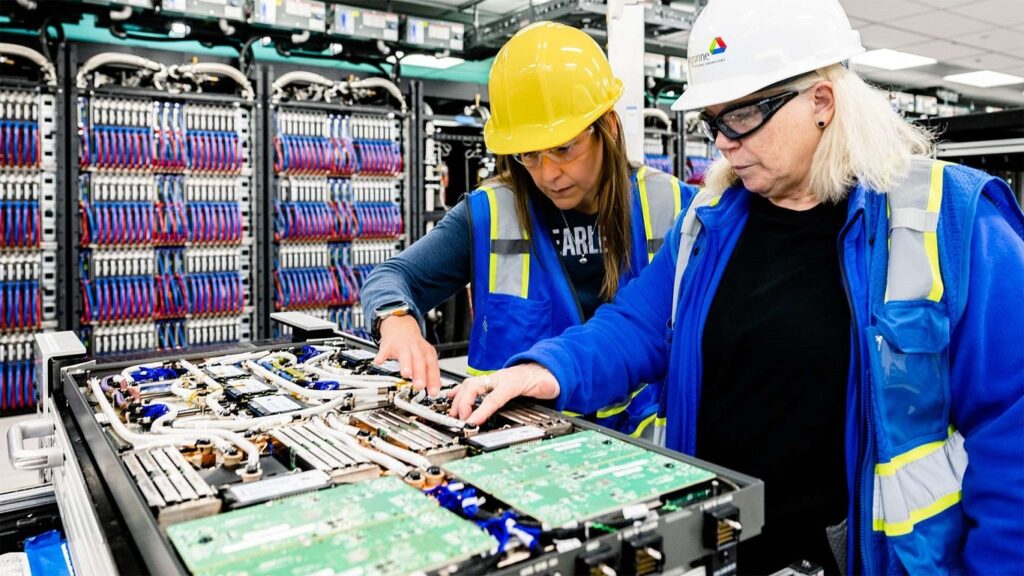Argonne National Laboratory’s Aurora supercomputer now has all 10,624 computing blades and is powered by 21,248 Intel Xeon® CPU Max Series and 63,744 Intel Data Centre GPU Max Series processors.
Aurora is the largest GPU cluster in the world, the largest Xeon Max CPU-based system, and the first deployment of Intel’s Max Series GPU(AMD Super Computer). We’re thrilled about the ground-breaking AI, research, and engineering Aurora will allow and delighted to be a part of this historic system.
What is Aurora
The Aurora supercomputer, a joint effort between Intel, HPE, and DOE, is intended to fully realise the potential of the three pillars of high performance computing (HPC): simulations, data analytics, and artificial intelligence (AI) on a massive scale. The system uses the HPE Slingshot high-performance fabric and includes more than 1,024 storage nodes (using DAOS, Intel’s distributed asynchronous object storage), offering 220 petabytes (PB) of capacity at 31 terabytes per second of total bandwidth. When Aurora joins the TOP500 list later this year, it’s anticipated that it will be the first supercomputer in the world to theoretically reach a peak speed of more than 2 exaflops (one exaflop is 1018, or a billion billion operations per second).

The GPU and CPU product families from Intel’s Max Series will be fully used by Aurora. Early results with the Max Series GPUs demonstrate leading performance on real-world science and engineering workloads, showcasing up to 2 times the performance of AMD MI250X GPUs on OpenMC and near linear scaling up to hundreds of nodes. The Max Series GPUs are designed to meet the demands of dynamic and emerging HPC and AI workloads.40% performance advantage over the competition is delivered by the Intel Xeon Max Series CPU in a variety of real-world HPC tasks, including manufacturing, energy, and modelling of earth systems.
What’s Important
Researchers face enormous difficulties that call for the use of powerful computer technology at scale, from combating climate change to discovering treatments for fatal illnesses. With Aurora, the demands of the HPC and AI communities will be met, and the instruments required to further scientific inquiry will be made available.
According to Rick Stevens, associate laboratory director at Argonne National Laboratory, “we’re going to be using Aurora to train some large-scale open source generative AI models for science while we work towards acceptance testing.” Aurora is the ideal environment for training these models since it has over 60,000 Intel Max GPUs, a lightning-fast I/O system, and an all-solid-state mass storage system.
How It Operates
The sleek, rectangular Aurora blades that house the processors, memory, networking, and cooling technologies are the brains of this cutting-edge system. Two Intel Xeon Max Series CPUs and six Intel Max Series GPUs make up each blade. On Sunspot, the test platform and development system with the same architecture as Aurora, the Xeon Max Series product line has already shown excellent early performance. OneAPI and AI tools are being used by developers to speed up HPC and AI workloads and improve code portability across various systems.
Each 70-pound blade had to be vertically integrated into Aurora’s refrigerator-sized racks using specialised equipment, making the installation of these blades a delicate process. The system’s 166 racks, which span eight rows and can hold 64 blades apiece, take up the same amount of room as two varsity basketball courts in the Argonne Leadership Computing Facility (ALCF) data centre.
Researchers from the DOE’s Exascale Computing Project and the ALCF’s Aurora Early Science Programme (ESP) will transition their work from the Sunspot test bed to the fully operational Aurora. They will be able to scale their applications over the entire system after this transformation. Early users will put the supercomputer through a stress test to find any faults that need to be fixed before deployment. The recent ISC’23 conference announcement to build generative AI models for research falls under this category.
FAQs
-
What is the Aurora supercomputer?
Aurora is a planned exascale supercomputer to be completed in 2023. It is sponsored by the United States Department of Energy (DOE) and designed by Intel and Cray for the Argonne National Laboratory. It will have c. 2 exaFLOPS in computing power which is approximately a quintillion (260 or 1018) calculations per second and will have an expected cost of US$500 million. It will follow Frontier, which was the world’s first exascale supercomputer in 2022.
-
What are the main features of Aurora?
The main features of Aurora include:
Exascale computing power: Aurora will be one of the first exascale supercomputers in the world. This means that it will be able to perform over one quintillion calculations per second.
Intel Xeon Max processors: Aurora will use Intel Xeon Max processors, which are some of the most powerful processors available today.
Cray Slingshot interconnect: Aurora will use Cray Slingshot interconnect, which is one of the fastest interconnects available today.
230 petabytes of storage: Aurora will have 230 petabytes of storage, which is enough to store over 200 million terabytes of data. -
What are the uses for Aurora?
Aurora is expected to be used for a variety of applications, including:
Nuclear fusion research: Aurora will be used to simulate nuclear fusion reactions, which could lead to the development of new sources of clean energy.
Climate research: Aurora will be used to simulate climate change, which could help scientists to better understand the effects of climate change and develop solutions to mitigate its effects.
Drug discovery: Aurora will be used to simulate the behavior of molecules, which could help scientists to develop new drugs and treatments for diseases.
Material science: Aurora will be used to simulate the behavior of materials, which could help scientists to develop new materials with improved properties. -
Where will Aurora be located?
Aurora will be located at the Argonne National Laboratory in Illinois.
-
Who will be able to use Aurora?
Aurora will be available to researchers from around the world.
-
How much will Aurora cost?
The estimated cost of Aurora is US$500 million.
-
What are the benefits of Aurora?
The benefits of Aurora include:
New discoveries: Aurora will help scientists to make new discoveries in a variety of fields.
Improved understanding: Aurora will help scientists to better understand the world around them.
New technologies: Aurora will help to develop new technologies that can improve our lives.
A cleaner future: Aurora could help to develop new sources of clean energy, which could help to reduce pollution and protect the environment. -
What are the security considerations for Aurora?
Aurora will be a very secure system, and it will be protected by a variety of security measures. These measures will include:
Physical security: Aurora will be housed in a secure facility, and access to the system will be restricted.
Cybersecurity: Aurora will be protected by a variety of cybersecurity measures, such as firewalls and intrusion detection systems.
Data encryption: All of the data on Aurora will be encrypted, which will help to protect it from unauthorized access. -
How many Nodes in Aurora SuperComputer?
Aurora will have 18,000 nodes, each with 64 Intel Xeon Scalable processors and 1.6 TB of memory. This will give Aurora a total of 1,152,000 processors and 288 TB of memory.
The Aurora nodes will be connected using Cray’s Slingshot interconnect, which will provide a peak bandwidth of 200 GB/s per node. This will allow Aurora to achieve a peak performance of 2 exaFLOPS.


[…] Installation of the Aurora Supercomputer Blade has finished Google Cloud Unleashes AI on Money Laundering Activities After Successful HSBC Trial […]
[…] geospatial data as we welcome Planetary Computer to Azure Space. Geospatial platform Planetary Computer is strong. It has a multi-petabyte database of global multi-source data, intuitive APIs, a flexible […]
[…] computing (HPC) at SC23. Intel provided an update on the 1 trillion parameter GPT-3 LLM on the Aurora supercomputers, which is made possible by the special architecture of the Max Series GPU and the system […]